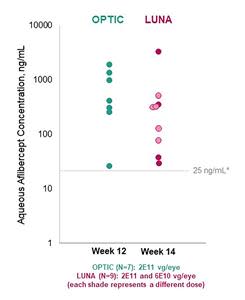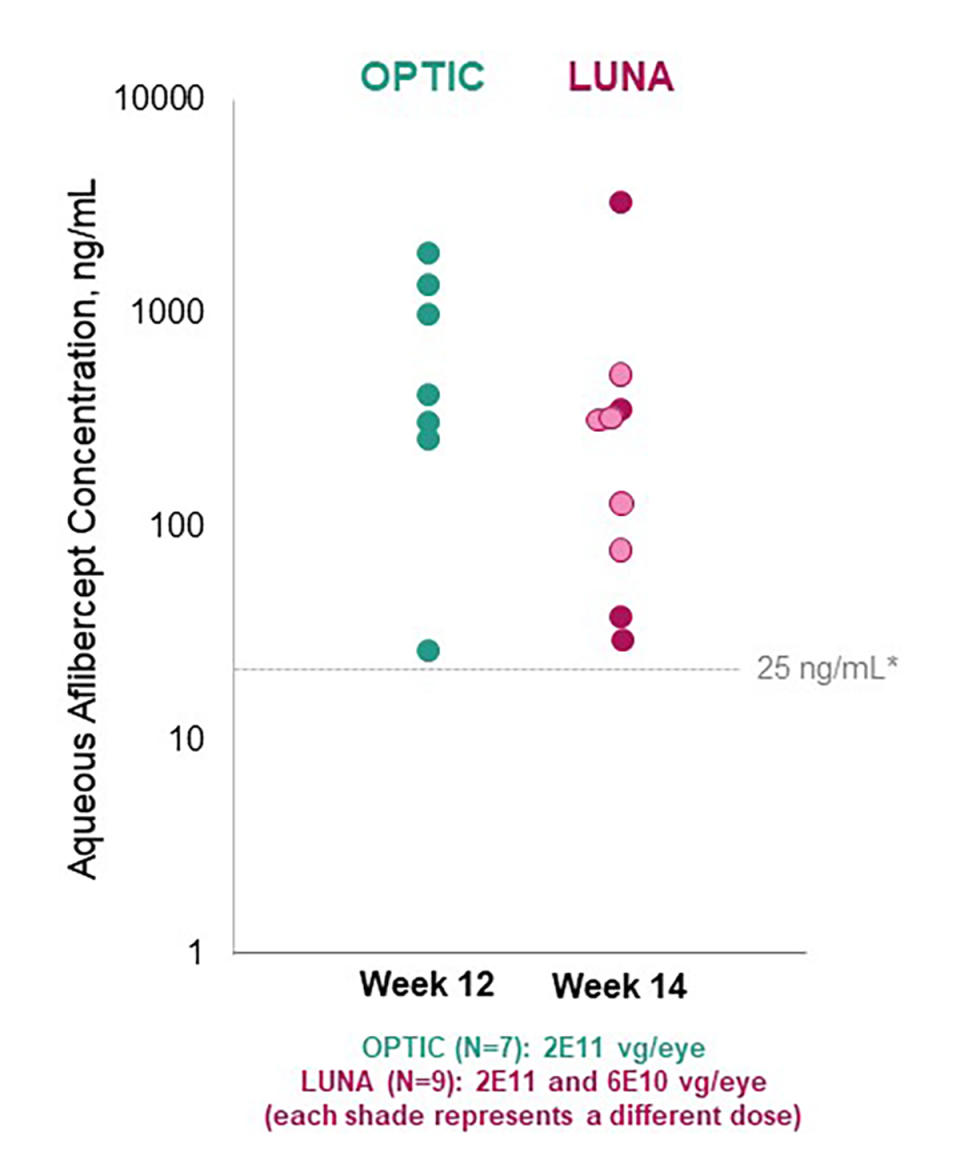Adverum Biotechnologies Announces Positive Aflibercept Protein Level Data from the LUNA Phase 2 Trial


Aqueous Aflibercept Protein Expression Levels in LUNA and OPTIC Trials


- Initial aflibercept protein levels in LUNA suggest Ixo-vec at both the 2E11 and 6E10 doses delivers aflibercept protein levels within the therapeutically active range -
- Ixo-vec has been well tolerated with a favorable preliminary safety profile -
- Initial Phase 2 LUNA efficacy and safety data anticipated in Q4 2023 -
REDWOOD CITY, Calif., Sept. 26, 2023 (GLOBE NEWSWIRE) -- Adverum Biotechnologies, Inc. (Nasdaq: ADVM), a clinical-stage company that aims to establish gene therapy as a new standard of care for highly prevalent ocular diseases, today announced initial aflibercept protein expression data from its ongoing Phase 2 LUNA trial evaluating ixoberogene soroparvovec (Ixo-vec) for the treatment of wet age-related macular degeneration (wet AMD). New data announced today include aflibercept protein levels for both the 2E11 and 6E10 vg/eye doses, suggesting that both doses are within the therapeutically active range. Notably, these protein expression levels are consistent with levels observed in the OPTIC trial, in which aflibercept levels and corresponding clinical activity have been sustained in patients through multiple years of follow-up after a single Ixo-vec injection.
“This first data cut from the LUNA trial is highly encouraging, showing similar aflibercept expression levels at the 2E11 and 6E10 doses,” stated Laurent Fischer, M.D., president and chief executive officer of Adverum Biotechnologies. “Unlike the current standard of care that requires multiple bolus injections in the eye every year to maintain sufficient levels of aflibercept, gene therapy has the potential to dramatically reduce treatment burden for the life of the patient by delivering durable therapeutic levels of anti-VEGF. The aflibercept levels across the 2E11 and 6E10 doses are in the range observed in the OPTIC trial and in the range that was seen in previously presented non-human primate data. The efficacy of Ixo-vec at the 2E11 dose in OPTIC remain very promising. LUNA was designed to further optimize Ixo-vec's profile, by exploring improved corticosteroid prophylactic regimens and the potential to dose lower. Our preliminary LUNA data reinforce our hypothesis that Ixo-vec at both the 2E11 and 6E10 doses has the potential to produce a robust clinical activity with an acceptable safety profile.”
Dr. Fischer continued, “We are pleased with the promising emerging LUNA clinical activity and safety data. At AAO this year, we look forward to presenting updated long-term follow-up data from the OPTIC trial, showing aflibercept protein levels out to four years, and clinical efficacy and safety data out to three years after a single Ixo-vec injection. We also look forward to providing initial LUNA clinical activity and safety data once a meaningful subset of patients have completed the corticosteroid prophylactic taper regimens.”
“The preliminary aqueous aflibercept protein data are consistent with levels known to be therapeutic and suggest that, in previously-treated neovascular age-related macular degeneration patients, both the 2E11 and 6E10 doses of Ixo-vec have the potential for sustained efficacy after a single administration,” said Arshad M. Khanani, M.D., M.A., managing partner and director of clinical research, Sierra Eye Associates, member of Adverum’s Scientific Advisory Board and principal investigator of the LUNA and the OPTIC trials. “Ixo-vec utilizes the 7m8 capsid developed via directed evolution to enhance retinal transduction and to deliver therapy where it is needed most. These results from the LUNA study could be clinically meaningful as the aflibercept levels measured in this trial are comparable to the sustained aflibercept levels seen in patients treated in the OPTIC trial.”
Ixo-vec Phase 2 LUNA Preliminary Aflibercept Protein Level Data Highlights
Background:
Ixo-vec is an aflibercept-encoding AAV.7m8 vector designed via directed evolution to cross the inner limiting membrane, enabling in-clinic IVT delivery and enhanced retinal transduction.
Aqueous aflibercept protein levels in LUNA
The Phase 2 LUNA trial was designed to inform the selection of Ixo-vec dose(s) and corticosteroid prophylactic regimen(s) for the design of Phase 3 registrational trials.
Aqueous aflibercept levels measured in LUNA at this early week 14 time point are a predictive biomarker of the higher and therapeutically relevant aflibercept levels in the retina and choroid.
Non-human primate data confirm robust expression of aflibercept in the retina and choroid after a single IVT injection of Ixo-vec at levels approximately nine-fold higher than those measured in the aqueous humor.
OPTIC clinical activity and safety
In OPTIC, the 2E11 dose of Ixo-vec performed well through two years, demonstrating efficacy that remains highly promising, with an acceptable safety profile.
Patients demonstrated early aflibercept levels sustained through at least three years of follow-up and also demonstrated clinical benefit, including vision maintenance, fluid control and a significant reduction in treatment burden.
OPTIC patients with a broad range of aqueous aflibercept levels achieved clinical benefit. Notably one subject had an 85% reduction in annualized supplemental aflibercept injections over 45 months of follow up and had aflibercept levels at multiple time points below or at the threshold of the limit of quantification of our assay (data on file).
Trial Design & Key Baseline Characteristics:
The LUNA trial is evaluating the efficacy and safety of Ixo-vec in 60 subjects randomized equally between the 2E11 and 6E10 doses.
LUNA was fully enrolled in August 2023, and as of the July 24, 2023 data cut-off, 12 patient samples have been collected and analyzed for aflibercept protein levels in the aqueous humor.
The LUNA trial population has similar visual acuity and injection frequency baseline characteristics to the study population of OPTIC.
In particular, the mean annualized anti-VEGF injection rate in the 12 months prior to Ixo-vec treatment in LUNA is approximately nine injections, indicating that these subjects require frequent injections, administered approximately every six weeks.
Aqueous Aflibercept Protein Expression Levels:
Aflibercept protein data suggest Ixo-vec at the 2E11 and 6E10 doses deliver similar levels of aflibercept that are both within the therapeutically active range based on OPTIC and non-human primate data.

*In LUNA, 12 of 14 eligible subjects had aqueous taps as of the July 24, 2023 data cut-off date. Data are shown for nine LUNA subjects. The other three subjects (including subjects at both dose levels) had aflibercept levels below the limit of quantification (25ng/ml) of our ELISA assay.
Preliminary LUNA Clinical Activity and Safety Summary:
Ixo-vec early clinical activity is encouraging and as anticipated, Ixo-vec has been generally well-tolerated with a favorable safety profile as of the data cut-off date.
Over 90% of subjects were still receiving corticosteroid prophylactic taper as of the data cut-off date.
Anticipated Clinical Program Milestones
Q4 2023: | Presentation of OPTIC four-year Ixo-vec aflibercept protein expression data and three-year extension efficacy and safety data at the American Academy Ophthalmology (AAO) Meeting in November 2023. |
|
|
Q4 2023: | LUNA preliminary efficacy and safety data. |
|
|
Mid-2024: | Additional LUNA data, including the 26-week interim analysis. |
|
|
About Wet Age-Related Macular Degeneration
Wet AMD, also known as neovascular AMD or nAMD, is a VEGF driven advanced form of AMD affecting approximately 10% of patients living with AMD associated with the build-up of fluid in the macula and the retina. Wet AMD is a leading cause of blindness in people over 65 years of age, with approximately 20 million individuals worldwide living with this condition. New cases of wet AMD are expected to grow significantly worldwide as populations age. AMD is expected to impact 288 million people worldwide by 2040, with wet AMD accounting for approximately 10% of those cases. Additionally, wet AMD is a bilateral disease, and incidence of nAMD in the second eye is up to 42% in the first two to three years. The current standard of care requires frequent life-long repeated bolus injections of anti-VEGF in the eye. IVT gene therapy has the promise to preserve vision and reduce most or all injections for the life of the patient by delivering stable therapeutic levels of anti-VEGF to control macular fluid.
About Ixo-vec in Wet AMD
Adverum is developing ixoberogene soroparvovec (Ixo-vec, formerly referred to as ADVM-022), its clinical-stage gene therapy product candidate, for the treatment of wet AMD. Ixo-vec utilizes a proprietary vector capsid, AAV.7m8, carrying an aflibercept coding sequence under the control of a proprietary expression cassette. Unlike other ophthalmic gene therapies that require surgery to administer the gene therapy under the retina (sub-retinal approach), Ixo-vec is designed to be administered as a one-time IVT injection in the physician’s office, deliver long-term efficacy, reduce the burden of frequent anti-vascular endothelial growth factor (VEGF) injections, optimize patient compliance and improve vision outcomes for patients with wet AMD. In recognition of the need for new treatment options for wet AMD, the U.S. Food and Drug Administration granted Fast Track designation for Ixo-vec for the treatment of wet AMD. Ixo-vec has also received PRIME designation from the European Medicines Agency and the Innovation Passport from the United Kingdom’s Medicines and Healthcare Products Regulatory Agency for the treatment of wet AMD.
About Adverum Biotechnologies
Adverum Biotechnologies (NASDAQ: ADVM) is a clinical-stage company that aims to establish gene therapy as a new standard of care for highly prevalent ocular diseases with the aspiration of developing functional cures to restore vision and prevent blindness. Leveraging the capabilities of its proprietary intravitreal (IVT) platform, Adverum is developing durable, single-administration therapies, designed to be delivered in physicians’ offices, to eliminate the need for frequent ocular injections to treat these diseases. Adverum is evaluating its novel gene therapy candidate, ixoberogene soroparvovec (Ixo-vec, formerly referred to as ADVM-022), as a one-time, IVT injection for patients with neovascular or wet age-related macular degeneration. Additionally, by overcoming the challenges associated with current treatment paradigms for debilitating ocular diseases, Adverum aspires to transform the standard of care, preserve vision, and create a profound societal impact around the globe. For more information, please visit www.adverum.com.
Forward-looking Statements
Statements contained in this press release regarding events or results that may occur in the future are “forward-looking statements” within the meaning of the Private Securities Litigation Reform Act of 1995. Such statements include but are not limited to statements regarding the potential benefits of Ixo-vec in the treatment of wet AMD, the design of and enrollment in the LUNA trial, including the prophylactic corticosteroid regimens, anticipated preliminary and interim data from the LUNA trial and pipeline programs. Actual results could differ materially from those anticipated in such forward-looking statements as a result of various risks and uncertainties, including risks inherent to, without limitation: Adverum’s novel technology, which makes it difficult to predict the timing of commencement and completion of clinical trials; regulatory uncertainties; enrollment uncertainties; the results of early clinical trials not always being predictive of future clinical trials and results; and the potential for future complications or side effects in connection with use of Ixo-vec. Additional risks and uncertainties facing Adverum are set forth under the caption “Risk Factors” and elsewhere in Adverum’s Securities and Exchange Commission (SEC) filings and reports, including Adverum’s Quarterly Report on Form 10-Q for the quarter ended June 30, 2023 filed with the SEC on August 10, 2023. All forward-looking statements contained in this press release speak only as of the date on which they were made. Adverum undertakes no obligation to update such statements to reflect events that occur or circumstances that exist after the date on which they were made, except as required by law.
Inquiries:
Adverum Investor Relations
Email: ir@adverum.com
A photo accompanying this announcement is available at https://www.globenewswire.com/NewsRoom/AttachmentNg/9317bf70-25b3-4a58-ae91-9d5796b4560d

